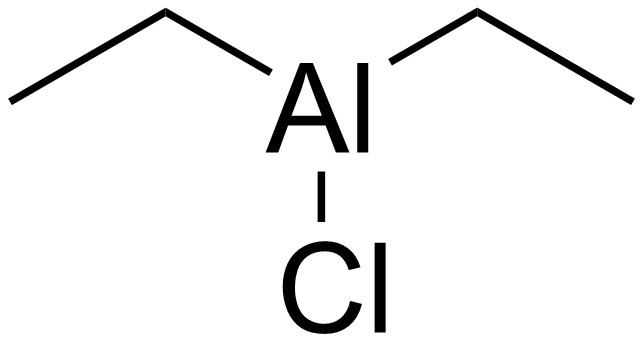Formula C4H10AlCl | Density 961 kg/m³ | |
 | ||
Diethylaluminium chloride is a highly hazardous organic compound and Lewis acid with the chemical formula C4H10AlCl. When dissolved in hexane, diethylaluminum chloride is a colorless liquid. It is used for polyolefin catalysis and as an intermediate in the preparation of organometallic compounds. It has a vapor density of 4.2 (air=1).
Contents
Safety
Diethylaluminum chloride is very difficult to handle. Diethylaluminum chloride is extremely flammable, and thus must be kept away from sparks, flames, or any source of ignition. The compound must be kept in a tightly closed steel container, in a cool, dry room where temperatures and pressures do not vary frequently, when the compound is not in use. This compound is typically manipulated under a fume hood, and, for more protection, wearing a respirator when the container is open. Direct physical contact is avoided by wearing protective gloves, eyewear, and clothing. In case of a spill of diethylaluminum chloride, the documented procedure is to first get rid of all ignition sources and prevent water from coming in contact with the spill. Then the spill is covered with dry earth or sand, followed by a plastic sheet. Finally the spill is swept up and disposed of properly.
Effects of exposure and first aid
If diethylaluminum chloride is ingested one may experience burns of the esophagus and stomach. The person may be more likely to vomit or drool. If this happens one can dilute the solution by drinking water or milk, but no more than 8 ounces. Seek medical attention immediately. If the compound is inhaled burning of the nasal and throat passageways may occur and cause upper airway injury. Should this occur move the person to fresh air, seek medical attention immediately. The medical personnel might administer oxygen or assist in ventilation. Lastly, if the compound comes in contact with the skin or eyes severe skin and eye irritation may occur as well as burns. If it comes in contact with your skin, first remove contaminated clothes, then run skin under water for 15 minutes, finally, if necessary see a physician if burning persists. If the compound comes into contact with the eyes run eyes under copious amounts of water for 30 minutes, then see a doctor immediately.
Reactivity with fire and water
Diethylaluminum chloride vapors can diffuse throughout a room and catch fire from an ignition source and create a flash back. The fire created by diethylaluminum chloride will create very hazardous gases that are toxic when inhaled. To stop a fire created by diethylaluminum chloride, foam, dry chemical, or carbon dioxide should be used. The compound may also re-ignite after extinction because of its high reactivity. Water should never be used to put out the flames as this will cause diethylaluminum chloride to react even more violently. Diethylaluminum chloride is so reactive with water that it may even ignite upon contact with moisture in the air.
